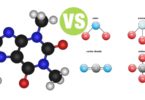Cell Membrane and Nuclear Membrane are two of the most common terms which are studied in medical sciences. To differentiate between the two terms, we are going to do this detailed article explaining the major difference between the cell membrane and nuclear membrane. While the objective is quite clear, we shall proceed with it.
Cell Membrane: Definition and Functions.
Cell membrane is a protective sheath, enveloping the cell body. It is also known as plasma membrane or plasmalemma. This membrane separates the fluid outside the cell called extracellular fluid (ECF) and the fluid inside the cell called intracellular fluid (ICF). The cell membrane is a semipermeable membrane. So, there is free exchange of certain substances between ECF and ICF. Thickness of the cell membrane varies from 75 to 111.
Composition of Cell Membrane:
Cell membrane is composed of three types of substances:
- Proteins (55%)
- Lipids (40%)
- Carbohydrates (5%).
Structure of Cell Membrane:
On the basis of structure, cell membrane is called a unit membrane or a three-layered membrane. The electron microscopic study reveals three layers of cell membrane, namely, one central electron-lucent layer and two electron-dense layers. The two electron-dense layers are placed one on either side of the central layer.
The central layer is a lipid layer formed by lipid substances. The other two layers are protein layers formed by proteins. Cell membrane contains some carbohydrate molecules also.
Functions of Cell Membrane:
The following is a list of all functions which the cell membrane performs in our body:
- Protective function: Cell membrane protects the cytoplasm and the organelles present in the cytoplasm
- Selective permeability: Cell membrane acts as a semipermeable membrane, which allows only some substances to pass through it and acts as a barrier for other substances
- Absorptive function: Nutrients are absorbed into the cell through the cell membrane
- Excretory function: Metabolites and other waste products from the cell are excreted out through the cell membrane
- Exchange of gases: Oxygen enters the cell from the blood and carbon dioxide leaves the cell and enters the blood through the cell membrane
- Maintenance of shape and size of the cell: Cell membrane is responsible for the maintenance of shape and size of the cell.
Nuclear Membrane: Definition and Functions.
On the other hand, Nuclear membrane is double layered and porous in nature. This allows the nucleoplasm to communicate with the cytoplasm. The outer layer of nuclear membrane is continuous with the membrane of endoplasmic reticulum. The space between the two layers of nuclear membrane is continuous with the lumen of endoplasmic reticulum.
Pores of the nuclear membrane are guarded (lined) by protein molecules. Diameter of the pores is about 80 to 100 nm. However, it is decreased to about 7 to 9 nm because of the attachment of protein molecules with the periphery of the pores. Exchange of materials between nucleoplasm and cytoplasm occurs through these pores.
So these were the major differences between a cell membrane and nuclear membrane. I hope we made everything quite clear for the readers. To remove more of such confusions, keep visiting our website.







Leave a Comment
You must be logged in to post a comment.